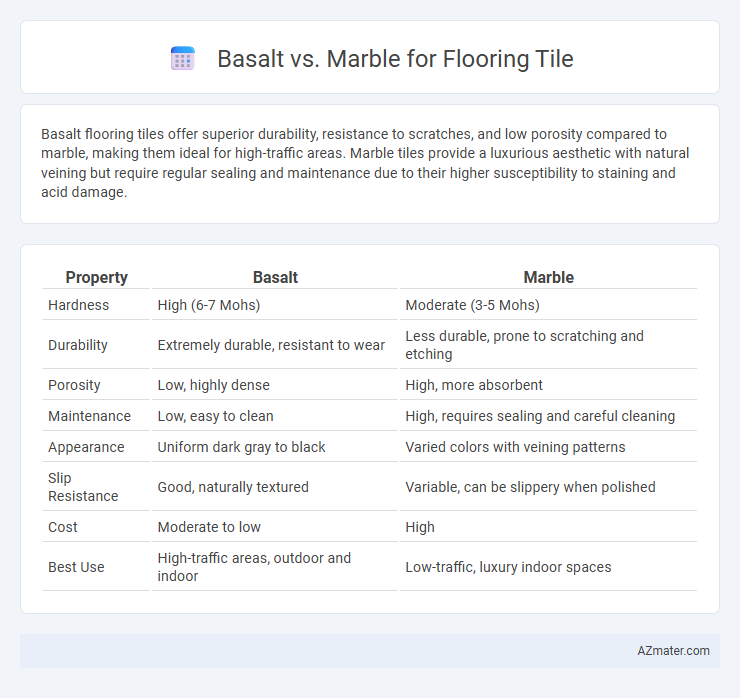Basalt flooring tiles offer superior durability, resistance to scratches, and low porosity compared to marble, making them ideal for high-traffic areas. Marble tiles provide a luxurious aesthetic with natural veining but require regular sealing and maintenance due to their higher susceptibility to staining and acid damage.
Table of Comparison
| Property | Basalt | Marble |
|---|---|---|
| Hardness | High (6-7 Mohs) | Moderate (3-5 Mohs) |
| Durability | Extremely durable, resistant to wear | Less durable, prone to scratching and etching |
| Porosity | Low, highly dense | High, more absorbent |
| Maintenance | Low, easy to clean | High, requires sealing and careful cleaning |
| Appearance | Uniform dark gray to black | Varied colors with veining patterns |
| Slip Resistance | Good, naturally textured | Variable, can be slippery when polished |
| Cost | Moderate to low | High |
| Best Use | High-traffic areas, outdoor and indoor | Low-traffic, luxury indoor spaces |
Introduction to Basalt and Marble Flooring
Basalt flooring tiles, formed from volcanic rock, offer exceptional durability and a naturally textured surface ideal for high-traffic areas, while marble flooring tiles, composed of metamorphic limestone, provide a luxurious, polished appearance with unique veining patterns. Both materials boast distinctive aesthetic qualities and varying maintenance requirements, with basalt favored for slip resistance and marble valued for its classic elegance. Choosing between basalt and marble flooring depends on factors such as desired style, durability needs, and budget considerations.
Key Physical Properties: Basalt vs Marble
Basalt flooring tiles are renowned for their exceptional hardness, with a Mohs scale rating of about 6, making them highly resistant to scratches and wear compared to marble, which rates around 3 to 5. Basalt exhibits low porosity, enhancing its durability and resistance to moisture, while marble's higher porosity requires regular sealing to prevent staining and damage. Thermal conductivity in basalt is lower than marble, offering better heat retention and making basalt preferable for radiant floor heating systems.
Aesthetic Differences: Color and Texture
Basalt flooring tiles showcase a deep, consistent dark gray to black color with a fine-grained, smooth texture that provides a modern, minimalist aesthetic. Marble tiles offer a luxurious appearance characterized by a broad spectrum of colors from white to green, pink, and black, featuring distinctive veining patterns and a polished or honed surface. The choice between basalt and marble flooring tiles hinges on the desired visual impact, where basalt delivers uniform elegance and marble creates dynamic, natural artistry.
Durability and Longevity Comparison
Basalt offers exceptional durability due to its dense, igneous composition, making it highly resistant to wear, scratches, and heavy foot traffic, ideal for high-use flooring areas. Marble, while aesthetically elegant with its crystalline structure, is softer and more porous, making it prone to scratching, staining, and etching, which can reduce its longevity in comparison to basalt. Over time, basalt maintains structural integrity with minimal maintenance, whereas marble requires regular sealing and care to preserve its surface and prevent damage.
Slip Resistance and Safety Features
Basalt flooring tiles offer superior slip resistance due to their naturally rough texture and high coefficient of friction, making them ideal for areas prone to moisture and heavy foot traffic. Marble tiles, while aesthetically elegant with a polished finish, tend to be more slippery when wet, requiring additional treatments such as anti-slip coatings or textured finishes to enhance safety. Prioritizing slip resistance, basalt provides a safer flooring option in environments where safety is critical.
Maintenance Requirements for Each Stone
Basalt flooring tiles require minimal maintenance due to their dense, non-porous nature, making them resistant to staining and easy to clean with regular sweeping and occasional mopping. Marble, being a softer and more porous natural stone, demands more diligent upkeep, including frequent sealing to prevent stains and etching from acidic substances, along with gentle, pH-neutral cleaners to maintain its polished appearance. Choosing basalt reduces long-term maintenance costs and effort, while marble's upkeep is higher but offers a classic, elegant aesthetic.
Cost Factors: Basalt vs Marble Flooring
Basalt flooring tiles generally cost less than marble due to basalt's abundant availability and simpler quarrying process, making it a budget-friendly option for durable flooring. Marble flooring commands higher prices because of its natural veining, intricate extraction, and labor-intensive polishing, which significantly increase installation costs. Maintenance expenses also differ as marble requires regular sealing and care to prevent staining, whereas basalt offers greater resistance to wear and lower long-term upkeep costs.
Environmental Impact and Sustainability
Basalt flooring tiles exhibit a lower environmental impact due to their abundant natural availability and minimal processing requirements, reducing energy consumption and carbon emissions compared to marble. Marble extraction often involves quarrying methods that cause significant habitat disruption and generate higher levels of waste and dust. Basalt's durability and resistance to weathering contribute to extended product lifespan, enhancing sustainability by minimizing replacement frequency and resource use.
Best Applications and Ideal Spaces
Basalt flooring tile, known for its durability and slip resistance, is ideal for high-traffic areas like kitchens, bathrooms, and outdoor spaces where moisture and wear are concerns. Marble's elegant appearance and smooth, polished surface make it best suited for living rooms, entryways, and formal areas that benefit from its luxurious aesthetic but require gentle maintenance. Choosing between basalt and marble depends on balancing functional needs such as toughness and moisture resistance with design preferences centered on sophistication and shine.
Final Recommendations and Conclusion
Basalt flooring tiles offer exceptional durability and a modern, dark aesthetic, making them ideal for high-traffic areas and contemporary designs. Marble tiles provide timeless elegance and a luxurious shine but require more maintenance due to their softness and porosity. For long-lasting, low-maintenance flooring, basalt is the preferred choice, while marble suits spaces prioritizing classic beauty over wear resistance.

Infographic: Basalt vs Marble for Flooring Tile
 azmater.com
azmater.com